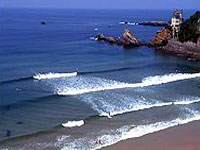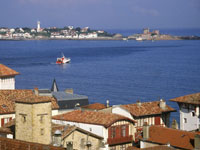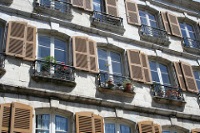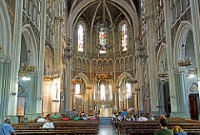Basque Country Travel Guide
France's three Basque provinces are in the southwest corner of the country, near the Spanish border, and are steeped in folklore and ancient customs. Men can still be seen in the traditional costume of a beret and cummerbund, towns and villages all have concrete courts for the playing of the national ball-game, pelota, and bullfighting is a popular spectator sport.
Most visitors head for the Atlantic coast to the popular resort towns of Biarritz and St-Jean-de-Luz, or to explore the Basque capital, Bayonne. Hikers and nature lovers are drawn to the grand Pyrenees Mountains to fish for fat trout, wander the trails, dip in warm mineral pools, marvel at the glaciers or climb challenging peaks.
In the Bigorre region, close to Basque country, is the Roman Catholic shrine at Lourdes, where the Virgin Mary is said to have appeared to a peasant girl in the mid-19th century.
Things to do in Basque Country
The majority of things to see and do in Basque Country revolve around the natural splendour of the region. The mountains and coastal scenery are spectacular and it is a particularly good area for walking trips.
Bayonne is a well-preserved cathedral city with traditional narrow cobbled streets and half-timbered houses. Tourists can visit the magnificent 13th-century Cathedrale Ste-Marie and the Basque Museum. Biarritz, a beloved holiday destination of the aristocracy for centuries, adjoins Bayonne and is spectacular, offering lovely beaches and the best surfing in France.
The great Roman Catholic pilgrimage town of Lourdes, situated in the dramatic Hautes-Pyranees, draws thousands of visitors. Although the grotto, with its miraculous healing waters, is the main attraction, this beautiful village also offers some good historical sightseeing. The Fortified Castle is worthwhile and there are a number of wonderful old churches in the area.

Biarritz
The holiday destination of Biarritz became famous in the 19th century when Empress Eugenie (the wife of Napoleon III) fell in love with this part of the Basque country and built a palace on the beach (now the world-class Hotel du Palais) and a centre with natural springs at Eugenie les Bains.
Biarritz is now a luxurious seaside tourist resort. The main beach Grande Plage offers striped 1920s-style beach tents for hire. After a morning relaxing in the sun, visitors can take in the fine collection of Asian art at the Asiatica Museum (acknowledged as the finest collection of its kind outside Paris) or wander through the Halles market hall. Also worth a look is the famous blue dome of the Russian Orthodox Church, built in the 19th century for visiting aristocrats. Families will enjoy the sharks and seals living at the Museum of the Sea aquarium; the lighthouse overlooking Cape Hainsart offers an exceptional panoramic view of Biarritz and the Basque hinterland.
Biarritz has good sporting facilities, including some excellent golf courses and some of the best surfing in France. Each summer, surfers from all over the world come to Biarritz to ride the waves at the annual Surf Festival. Those after more gentle exercise while on holiday opt to stroll along Biarritz's principal promenade, Quai de la Grande Plage.

Saint Jean de Luz
Saint Jean de Luz is a lively and cosmopolitan town to visit. The lovely medieval town centre has been influenced by Spain and the Moors over the centuries and offers a charming mix of interesting architecture spread along the narrow streets, blending old and new buildings. Considered one of the most attractive cities in Basque country, the beaches, shops, spas and other attractions draw hordes of local and international tourists to this spot just above the Spanish border.
Saint Jean de Luz is an active fishing port, and seafood is a local specialty with fresh sardines, tuna, and anchovies available in abundance. Some of the best seafood restaurants in the region are around the town's main square.
The beach is well-equipped for sunbathing and watersports, and there is good surfing at Lafitenia Beach. There are many small museums, aquariums, caves, and interesting architectural sights in Saint Jean de Luz, including the Chateau d'Arturbie, with its castle and manicured gardens. La Maison Louis XIV has rich collections of antiques and collectibles, as well as wax figures of important 17th-century people. The lighthouse at Pointe Ste.-Barbe offers fantastic views of the area.
The pedestrian avenue Rue Gambetta provides the best shopping in St Jean de Luz, and visitors will find everything from clothes and linens to leather goods and books. The newer, more commercial end of Saint Jean de Luz is littered with chic shops and boutiques. Popular souvenirs include delectable chocolates and candies such as nougat and tourons.

Bayonne
The popular holiday destination of Bayonne is the capital of Basque country, and a beautifully preserved cathedral city. Divided by the Nive and Adour rivers, its narrow atmospheric streets are lined with half-timbered houses and are perfect for exploring on foot. Together with adjoining Anglet and Biarritz, Bayonne forms the continuous urban area known as BAB.
The city's most striking landmark is the magnificent gothic Cathédrale Ste-Marie, dating from the 13th century. Situated in the heart of the historic centre of Bayonne, it contains relics of St Leo, a 9th century Bishop of Bayonne who was martyred during a Saracen invasion. It was also listed as a World Heritage Site in 1998 as part of the French Pilgrimage Routes of Santiago de Compostela.
Bayonne has two museums that are well worth visiting: Le Musée Basque, which showcases the traditions, architecture, and decorative arts of the Basque region; and Le Musée Bonnat, which displays thousands of drawings and paintings from the 16th to 19th centuries, including works by Rubens, Greco and Ingres.
The Bayonne Festival takes place every year for five days from the first Wednesday in August and is an explosion of activity with cow races, bull fights in the Roman arena, candle-lit processions and marching bands. Bayonne is well-known for its chocolates, marzipan and prime-smoked ham, all of which is available at the wonderful Covered Market. And according to tradition, if not historically verified fact, the bayonet was invented here in the 1600s.

Lourdes
Not strictly Basque country, but part of the nearby Bigorre region, the town of Lourdes is situated in the Hautes-Pyrénées and has been one of the great Roman Catholic pilgrimage sites since the Virgin Mary allegedly revealed herself to a shepherd girl, Bernadette Soubirous, in 1858. More than five million pilgrims visit the town each year, particularly in August, from the Catholic nobility to the poverty-stricken sick and ailing.
Pilgrims are sometimes offended by the commercialisation of the shrine (there is a very good trade in candles and Lourdes water) but miracle cures have been documented by the church so it can be assumed this exploitation does not affect the healing properties of the spring in which the afflicted bathe in a grotto. The Virgin is said to have appeared 18 times at the Grotto of Massabielle and mass takes place here every day.
Lourdes itself is ancient and includes several sights of interest for holiday visitors. The Fortified Castle was successively a military fortress, a state prison and, in the 16th and 17th centuries, the residence of the counts of Bigorre. There are wonderful panoramic views of Lourdes town and the sanctuary from high on the fortifications. Since 1921 the castle has housed the Musée Pyrénéen, which exhibits the art, traditions and history of the Pyrénées.
There are some interesting churches to see while on holiday in this religious town. The Upper Basilica of the Immaculate Conception was built in 1854; the inside is as impressive as the magnificent exterior. The oval Basilica of Pius X is one of the world's largest churches, its underground chamber can hold as many as 20,000 people. Mass is held in six languages, including English, every Wednesday and Sunday at 3:30pm from April to October. The Musée Ste-Bernadette is nearby, as is the house where Bernadette was born which, along with the home of her parents, has become a shrine.
Pau
The popular holiday destination of Pau is situated 50 miles (80km) inland, high above the Gave de Pau River, and is a good base from which to explore the Pyrénées and the picturesque little villages of the Bearn region. This year-round holiday resort was frequented by the British in the early 19th century (at one time 20 percent of the population hailed from England) and many customs were imported from across the Channel to become entrenched, including fox hunting and afternoon tea.
Pau is home to 85,000 people and is the most cosmopolitan city in the western Pyrénées. While on holiday, panoramic views can best be enjoyed when strolling along the Boulevard des Pyrénées. Worthy Pau sightseeing excursions include the 12th-century Chateau de Pau, containing some interesting contemporary artefacts including a crib fashioned from a single tortoise shell. The Musée des Beaux-Arts is also worth a peek, with a collection of European paintings by the likes of El Greco, Degas, Zurbaran and Boudin. The people of the Pau and Bearn are very proud of their language (a variation of Occitan) and heritage and have indulged in friendly rivalry with the Basques of Bayonne for centuries.

The Pyrenees
The wild mountains of the Pyrénées stretch for 250 miles (402km) from the Atlantic to the Mediterranean and have for many centuries formed a natural frontier, physical, climatic and linguistic, between France and Spain. Second only to the Alps among the great mountain ranges of Western Europe, the Pyrénées are much less frequented, and still offer an exciting combination of knife-edged summits, small glaciers, forested valleys, mountain tarns and little-trodden summer passes. Splendid trails lead to the magnificent cirques and lake-spangled basins of France's Pyrénées National Park. Over on the Spanish side paths lead through the spectacular canyons of the Ordesa-Monte Perdido National Park, one of Europe's oldest nature reserves.
In 1997, the United Nations inscribed a portion of the French and Spanish Pyrénées near the French village of Gavarnie and the Spanish village of Torla on its list of World Heritage Sites. Here, nature over the eons has carved three stupendous glacial cirques, including the renowned Cirque de Gavarnie, and a 3,000-foot (914m) deep canyon called Ordesa: Spain's 'Grand Canyon.' Hiking in this region is very rewarding and the dramatic landscapes are breathtaking. Although some of the trails require hiking experience and fitness, visitors can also find easy day-walks.
France travel info
Electricity
The electrical current is 230 volts, 50Hz. European two-pin plugs are standard.
Language
French is the official language.
Money
The euro (EUR) is the official currency in France. Currency can be exchanged at banks, bureaux de change and some large hotels, though visitors will get a better exchange rate at the ATMs. Major credit cards are widely accepted, particularly in major tourist destinations. Foreign currency is not accepted.
Tipping
Most restaurants and hotels automatically add a 15 percent service charge so a tip is not necessary, although another two to three percent is customary if the service has been good. If service is not included then 15 percent is customary. Taxi drivers expect 10 to 15 percent of the fare, and hairdressers about 10 percent. Hotel staff generally receive about €1.50 a day and tips of about €1 are given to washroom and cloakroom attendants and museum tour guides. Tour bus drivers and guides are also tipped.
Health
No particular vaccinations or medications are required for travel to France. The prevalence of certain tick-borne infections, such as lyme disease, tularemia, tick-borne encephalitis, and rickettsial diseases, mean that travellers should take precautions against ticks if they are travelling in rural or forested areas in warm weather. French hospitals and health facilities are first class. Visitors from other EU countries are entitled to discounted medical treatment and medicines on presentation of a European Health Insurance Card (EHIC). After Brexit, the Global Health Insurance Card (GHIC) replaced the European Health Insurance Card (EHIC) for UK citizens. The GHIC allows UK citizens access to state healthcare during visits to the EU. The GHIC is not valid in Norway, Iceland, Liechtenstein or Switzerland, nor is it an alternative to travel insurance. Otherwise, doctors and hospitals often expect immediate cash payment for health services, so medical insurance is advised.
Safety
While violent crime against tourists is rare and holidays in France are generally trouble-free, visitors should be mindful that security has been heightened following a series of terrorist attacks in recent years, particularly in the transport sector. Unattended luggage left in public places will be removed or destroyed by security staff. While generally safe, visitors to France are advised to take precautions against petty theft and to ensure their personal safety. Thieves and pickpockets operate on the metro and around airports. Theft from cars is prevalent, particularly in the south, around Marseilles, and in Corsica. Tourists are advised to conceal bags and purses even when driving, and to never leave valuables unattended in the car. Bag snatching is also common, particularly on public transport and in shopping centres, and visitors should also be vigilant of luggage while loading bags into and out of hire cars at airports.
Local customs
French culture is of paramount importance to the French people. In an increasingly Americanised world they feel duty-bound to protect it, and it is appreciated if visitors can speak a few words of French. Locals do not respond well to being shouted at in English. While the food is second to none, foreigners may find the service in many restaurants sloppy. Waiters can appear rude (particularly in Paris) and take their time. This is just the way they are. Traditional games such as pétanque (similar to lawn bowling but played on gravel) are popular in village squares, but the national sports are football, rugby and cycling. Smoking in public places is not allowed and will incur heavy fines.
Doing business
Business etiquette is important in France. A smart, fashionable sense of dress is common as the nation prides itself on haut couture. Punctuality is not always observed though and the 'fashionably late' tactic may be applied. A handshake is the common form of greeting for men and women upon first introductions. Titles are important and the person is to be referred to as 'monsieur' (Mr.), 'madame' (Mrs.), or 'mademoiselle' (Ms.). Meetings usually occur over lunches, and the French are known to enjoy food. Business hours are generally 9am to 6pm, Monday to Friday.
Duty free
Travellers from non-EU countries over 17 years of age entering France can bring in the following items duty-free: 200 cigarettes, or 100 cigarillos, or 50 cigars, or 250g tobacco. Four litres of wine and 16 litres of beer and one litre of spirits over 22 percent or two litres of alcoholic beverages less than 22 percent. Other goods up to the value of €430 for air and sea travellers, and €300 for other travellers (reduced to €175 for children under 15 years of age).
Communications
The international access code for France is +33. Travellers can purchase local prepaid SIM cards for unlocked phones or use eSIMs if their cellular providers support it on their networks. Free WiFi is available in most hotels, cafes, restaurants and similar establishments.
Passport & Visa
The borderless region known as the Schengen Area includes the following countries: Austria, Belgium, Czech Republic, Denmark, Estonia, Finland, France, Germany, Greece, Hungary, Iceland, Italy, Latvia, Lithuania, Luxembourg, Malta, The Netherlands, Norway, Poland, Portugal, Slovakia, Slovenia, Spain, Sweden, and Switzerland. All these countries issue a standard Schengen visa that has a multiple entry option, and which allows the holder to travel freely within the borders of all the aforementioned countries.
Additionally, travellers must hold sufficient funds to cover their stay in France, and proof of repatriation (a return or onward ticket, and the necessary travel documentation for their next destination). Note that Schengen visas, if required, are also valid for French Guiana and French West Indies and Reunion, provided that the Schengen visa is endorsed "Also valid for French territories being in observation of the respective French territories". We recommend that passports always be valid for six months after intended period of travel.
Entry requirements
US citizens must have a passport that is valid for at least three months after their intended stay in France. No visa is required for a stay of up to 90 days within a 180 day period.
UK citizens must have a passport that is valid for at least three months after their intended stay in France. No visa is required for a stay of up to 90 days within a 180 day period.
Canadian citizens must have a passport that is valid for three months after their intended stay in France. No visa is required for a stay of up to 90 days in a 180 day period.
Australian citizens must have a passport that is valid for three months after their intended stay in France. No visa is required for a stay of up to 90 days in a 180 day period.
South African citizens must have a passport that is valid for three months after their intended stay, and a valid Schengen visa, to enter France. Note that entry and transit will be refused to holders of Temporary passports.
Irish citizens must have a passport that is valid on arrival. No visa is required.
New Zealand citizens must have a passport that is valid for three months after their intended stay in France. No visa is required for a stay of up to 90 days in a 180 day period.
Useful contacts
Maison de la France (Tourist Information Agency), Paris: www.france.fr/fr
112 (General emergency)Embassies / consulates in other countries
French Embassy, Washington DC, United States: +1 202 944 6195.
French Embassy, London, United Kingdom: +44 (0)20 7073 1000.
French Embassy, Ottawa, Canada: +1 613 789 1795.
French Embassy, Canberra, Australia: +61 (0)2 6216 0100.
French Embassy, Pretoria, South Africa: +27 (0)12 425 1600.
French Embassy, Dublin, Ireland: +353 (0)1 277 5000.
French Embassy, Wellington, New Zealand: +64 (0)4 384 2555.
Embassies / consulates in France
US Embassy, Paris: +33 (0)1 4312 2222.
British Embassy, Paris: +33 (0)1 4451 3100.
Canadian Embassy, Paris: +33 (0)1 4443 2900.
Australian Embassy, Paris: +33 (0)1 4059 3300.
South African Embassy, Paris: +33 (0)1 5359 2323.
Irish Embassy, Paris: +33 (0)1 4417 6700.
New Zealand Embassy, Paris: +33 (0)1 4501 4343.



